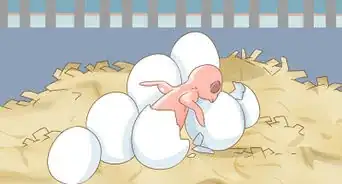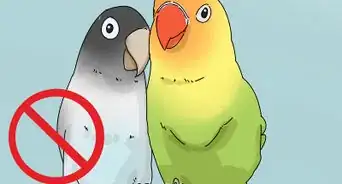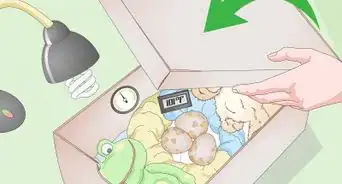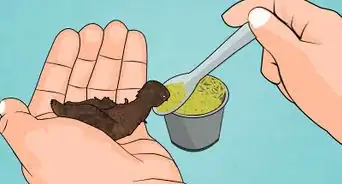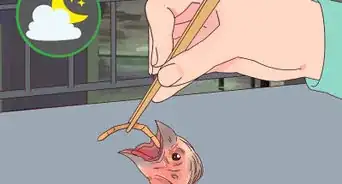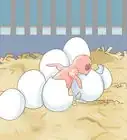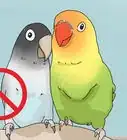This article was co-authored by Roger J. Lederer, PhD. Dr. Roger Lederer is an Ornithologist and the founder of Ornithology.com, an informative website about wild birds. Dr. Lederer has spent over 40 years teaching, studying, and writing about birds. He has traveled to over 100 countries to study birds. Dr. Lederer is an Emeritus Professor of Biological Sciences at California State University, Chico, and has been a Department Chair of Biological Sciences and Dean of the College of Natural Sciences. He has written more than 30 research papers and 10 books on birds and a textbook entitled “Ecology and Field Biology.” Dr. Lederer has consulted the BBC, National Geographic, National Public Radio, ABC News, the Guinness Book of World Records, and numerous other organizations and publications.
wikiHow marks an article as reader-approved once it receives enough positive feedback. In this case, 87% of readers who voted found the article helpful, earning it our reader-approved status.
This article has been viewed 301,350 times.
Whether you're looking to ensure your bird eggs are viable for breeding or just out of curiosity, checking to see if an egg is infertile can be quite easy. In most cases, it's possible to ensure your eggs are do not grow into chicks without even checking for infertility. Otherwise, there are several ways to check to see if an egg is infertile.
Steps
Checking Eggs for Fertility
-
1Candle an egg to look inside for embryonic development. If a you or a hen has been incubating an egg for a few days, you can candle an egg to see if it is fertile or not. Hold your egg up to a candle or strong light like an incubator light and observe what you see inside:[1] [2]
- A fertile egg will have clear signs of development such as networks of blood vessels present, an opaque shape of an embryo at the larger end of the egg, and even movement within the egg.
- A fertile egg with an embryo that has stopped developing will have a blood ring or blood streaks observable in the egg. Since the embryo is no longer viable, the blood vessels that once supported it have pulled away from it.
- An infertile egg or yolker will look fairly clear, with no blood streaks, rings, or vessels.
-
2Observe if your eggs float. Floating eggs are often infertile as the volume inside of the egg is not large enough for it to sink. As embryos form, eggs become heavier. Check for floating eggs: [3]
- Wait until your bird eggs are a few days old and all possible embryos have developed. In practice, it is best to only move possibly fertile eggs every once in a while and never too often. Taking an egg from its incubator too early can stunt development and taking an egg too late in its development can hurt the chick inside.
- Get a bowl of warm water. Be sure to use warm water in case your bird egg is fertile.
- Carefully place the eggs in the water. Be gentle, as some eggs are very fragile.
- Observe if your eggs float or sink.
- Return your fertile eggs back to the incubator as soon as possible.
Advertisement -
3Crack open an egg to check for fertility. The most accurate way to see if an egg is fertile or not in its early stages is to crack the egg open. When cracked, look for the blastodisc to see if it has turned into a blastoderm. For obvious reasons, cracking open an egg means you are not planning to breed or incubate chicks. If you're are cracking eggs for consumption, infertile eggs and fertile eggs have no taste difference.[4]
- Fertile eggs will have a blastoderm that looks like a white bullseye or circle. The white colour of the blastoderm will be quite opaque and its edges solid and pronounced. A lighter, almost transparent, outer later will surround the denser spot.
- Infertile eggs will have a blastodisc that will have an irregular shape and its white colour is very faint and foggy.
- All eggs will have a white spot or blastodisc whether or not it is fertile.
Ensuring Eggs Are Infertile
-
1Separate your female birds from your male birds. In order for an egg to be fertile, a female bird must mate with a male to produce an egg with both male and female genetic material to create an embryo inside the egg. If you only own female birds, then all eggs laid by them will be infertile.[5]
- An unfertilized egg or an egg only containing female genetic material is called a blastodisc.
- In fertile eggs or eggs that contain both female and male genetic material, the blastodisc is then term a blastoderm. The blastoderm is also called the first stage of embryonic development.
-
2Observe eggs for 14 to 21 days. The time it takes for a chick to hatch in incubation varies between different species of birds. Most lovebird eggs hatch in 2 weeks while chickens take up to 21 days to hatch.[6] If nothing happens to the egg past this period, the egg was most likely infertile or the embryo died and stopped its development.
- This method is not recommended for consumption if you are checking chicken eggs. If your egg has been in an incubator for 21 days or left out in room temperature for more than 7 to 10 days, the egg will have most likely gone bad or is beginning to rot.
Expert Q&A
-
QuestionWhat does an infertile egg look like?
 Roger J. Lederer, PhDDr. Roger Lederer is an Ornithologist and the founder of Ornithology.com, an informative website about wild birds. Dr. Lederer has spent over 40 years teaching, studying, and writing about birds. He has traveled to over 100 countries to study birds. Dr. Lederer is an Emeritus Professor of Biological Sciences at California State University, Chico, and has been a Department Chair of Biological Sciences and Dean of the College of Natural Sciences. He has written more than 30 research papers and 10 books on birds and a textbook entitled “Ecology and Field Biology.” Dr. Lederer has consulted the BBC, National Geographic, National Public Radio, ABC News, the Guinness Book of World Records, and numerous other organizations and publications.
Roger J. Lederer, PhDDr. Roger Lederer is an Ornithologist and the founder of Ornithology.com, an informative website about wild birds. Dr. Lederer has spent over 40 years teaching, studying, and writing about birds. He has traveled to over 100 countries to study birds. Dr. Lederer is an Emeritus Professor of Biological Sciences at California State University, Chico, and has been a Department Chair of Biological Sciences and Dean of the College of Natural Sciences. He has written more than 30 research papers and 10 books on birds and a textbook entitled “Ecology and Field Biology.” Dr. Lederer has consulted the BBC, National Geographic, National Public Radio, ABC News, the Guinness Book of World Records, and numerous other organizations and publications.
Ornithologist If you hold a strong light up behind an infertile egg, you won't see any embryo developing inside.
If you hold a strong light up behind an infertile egg, you won't see any embryo developing inside. -
QuestionA mother cardinal began sitting on her eggs a two and a half weeks ago with no evidence of hatchlings. Is there still a chance the eggs will hatch?
 Community AnswerYes, there is still a chance of hatching. Check after 30 days.
Community AnswerYes, there is still a chance of hatching. Check after 30 days. -
QuestionWhat does does it mean when you shine a light through the egg but there's a black mass or blob you can't see through?
 Community AnswerIf the whole egg is black, it's dead, but if there is just a dark mass inside, it's most likely the embryo developing.
Community AnswerIf the whole egg is black, it's dead, but if there is just a dark mass inside, it's most likely the embryo developing.
Warnings
- If you are not a professional breeder or wildlife expert, never try incubating wild bird eggs. They should be warmed and sent to a wildlife rehabilitation centre.⧼thumbs_response⧽
References
- ↑ Roger J. Lederer, PhD. Ornithologist. Expert Interview. 29 April 2021.
- ↑ https://extension.illinois.edu/eggs/res26-candling.html
- ↑ https://avianaquamiser.com/posts/float_test_of_egg_viability/
- ↑ https://www.thecapecoop.com/fertilized-vs-non-fertilized-eggs/
- ↑ http://www.the-chicken-chick.com/2013/01/facts-and-myths-about-fertile-eggs.html
- ↑ http://www.birds.cornell.edu/AllAboutBirds/faq/master_folder/baby_bird/document_view
About This Article
To tell if a bird egg is infertile, hold it up to a strong light or candle and examine the embryonic development inside the egg. If the inside looks fairly clear with no blood streaks, rings, or vessels, the egg is most likely infertile. Alternatively, see if the egg floats in a bowl of warm water, which is a common sign of infertility. You can also observe the egg for 14 to 21 days. If nothing happens to the egg past this period, it’s either infertile or the embryo has died during its development. To learn more, including how to stop an egg’s embryonic development, scroll down.






